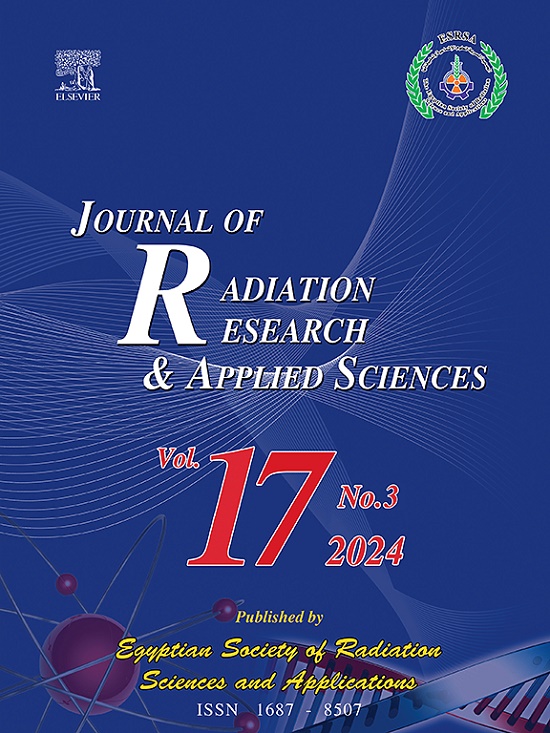热辐射对具有Soret和Dufour效应的MHD卡森流体二元化学反应流动的影响
IF 2.5
4区 综合性期刊
Q2 MULTIDISCIPLINARY SCIENCES
Journal of Radiation Research and Applied Sciences
Pub Date : 2025-06-03
DOI:10.1016/j.jrras.2025.101619
引用次数: 0
摘要
流体控制机制的动力学分析对于工业单位的杰出生产是非常必要的。具有独特特性的流变液的发展已经彻底改变了科技界,并对最终产品的取向产生了巨大的影响。在不同工艺中,以传统方式将所需能量与相关材料耦合,不能满足升级方面的要求。在这方面,与传统现象(传导和对流)相反,非常需要通过辐射源产生专属能量。辐射能量通量影响下的热流体输运的一些潜在应用被发现在太阳能和热板、电子仪器热回收管理、热交换器、食品加工、能量储存等领域。因此,该人工制品是起草来检查热液属性的粘弹性材料变形在弯曲拉伸表面受到新的物理因素。为了体现粘弹性流体的特性,引入了卡森流体模型。在分子水平上结合了温度相关的热导率。表示流量随流动温度变化的非线性变化的辐射被封装。与所考虑的轮廓有关的新物理因素的参与弯曲表面的拉伸和收缩也被泄露。在利用一组相似的变换后,以ODE的耦合设置形式对问题进行了最终的建模。采用BVP4C求解器,结合RK和射击程序进行了数值模拟。对偶性质的结果表示溶液对不同参数的稳定性,以图形方式显示。它描述了在曲面板表面的壁面阻力系数倾向于下降(上和下)分支对表面曲率的变化,而在传热系数的情况下观察到相反的方面。根据Nusselt数和Sherwood数,可以确定两者的上下分支对辐射参数的变化都是正的。本文章由计算机程序翻译,如有差异,请以英文原文为准。
Thermal radiation impacts on binary chemically reactive flow of MHD Casson fluid with Soret and Dufour effects
Dynamical analysis of mechanisms governed by fluids is highly essential for outstanding production from industrial units. The development of uniquely characterized rheological liquids has revolutionized the technological world and immensely impacted on orientation of finalized products. Coupling of the required energy to associated materials in different processes in customary ways does not fulfill the requirement of upgraded aspects. In this regard, the generation of exclusive energy in contrast to traditional phenomena (conduction and convection) is highly needed which is fulfilled through the radiative source. Some potential utilizations of thermofluidic transport under the influence of radiative energy flux are found in solar and thermal panels, electronic instrument heat recovery management, thermal exchangers, food processing, energy storing, and many more. So, this artifact is drafted to examine hydrothermal attributes of viscoelastic material deformation over a curved stretching surface subjected to novel physical factors. The Casson fluid model is included to exhibit features of viscoelastic fluid. Temperature-dependent thermal conductance at the molecular level is incorporated. Radiation expressing non-linear change in flux against temperature change in flow is encapsulated. Stretching and shrinking of the curved surface with the involvement of novel physical factors concerned with considered profiles are also divulged. Formulation of the problem in resultantly modeled in the form of ODE's coupled setup after utilizing a set of similar transformations. Numerical simulations are performed by BVP4C solver with RK and shooting procedures. Outcomes in dual natures expressing stability in solution against different parameters are displayed in a graphical manner. It is delineated that the wall drag coefficient at the surface of a curved sheet tends to decline for both (upper and lower) branches against change in curvature of the surface whereas opposite aspects are observed in the case of heat transfer coefficient. In view of Nusselt and Sherwood numbers, it is determined that both are showing positive change in the respect of lower and upper branches against radiation parameters.
求助全文
通过发布文献求助,成功后即可免费获取论文全文。
去求助
来源期刊

Journal of Radiation Research and Applied Sciences
MULTIDISCIPLINARY SCIENCES-
自引率
5.90%
发文量
130
审稿时长
16 weeks
期刊介绍:
Journal of Radiation Research and Applied Sciences provides a high quality medium for the publication of substantial, original and scientific and technological papers on the development and applications of nuclear, radiation and isotopes in biology, medicine, drugs, biochemistry, microbiology, agriculture, entomology, food technology, chemistry, physics, solid states, engineering, environmental and applied sciences.
 求助内容:
求助内容: 应助结果提醒方式:
应助结果提醒方式:


